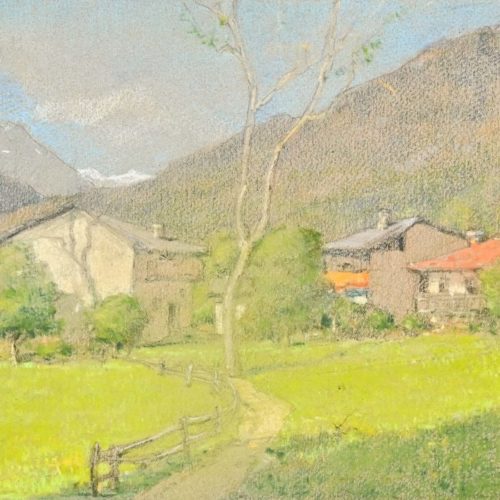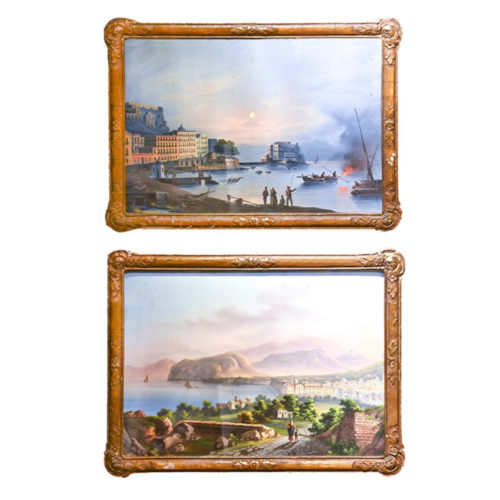Carlo Musso (1907 - 1968), gracious chalk on paper by the Turinese artist. Signed on the lower right, dating back to the 1940s.
Born on September 7th 1907 and dead on September 25th 1968 in Turin. He attended the Albertina Academy of Fine Arts along with the masters Luigi Onetti, Cesare Ferro and later on with Guido di Montezemolo. This last artist was his companion with whom he had learned to dig into the true soul of the Piedmontese landscapes, pictorically describing it with a deep sense of lyricism.
He participated in the main Italian group exhibitions: Circolo degli Artisti, Arbarello prize with the work 'Ponte sulla Dora' (1946); CAI Award, silver medal with 'Preludio di tormenta' (1947); Black and White exhibition, medal of silver San Paolo with Strada del fortino (1952); City of Chieri competition, first prize with "the Duomo, evening" (1953); International Self-portrait Exhibition, silver medal (1956); Circolo degli Artisti of Turin, Follini prize with "Porto di Savonasotto la neve" (1958); Alessandria Commerce Award, first prize with "Casale Market" (1962); Pragelato Narcisi in fiore competition, first prize (1966); Exhibition of Floral compositions at Valentino, gold medal ( 1966); City of Cumiana painting exhibition, first prize and gold medal with "Autumn in Val di Susa" (1966) He has set up personal exhibitions in various Italian cities.
Measurements: W 35 x H 22,5
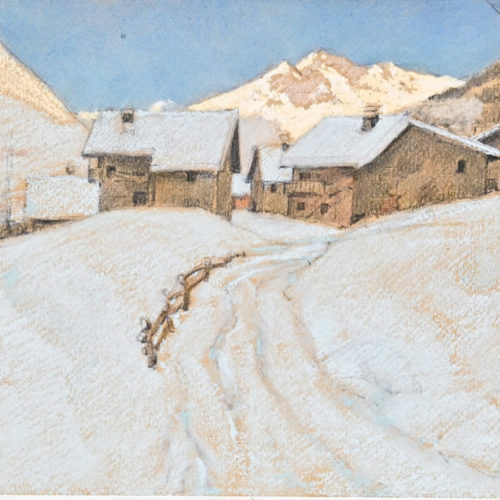 Carlo Musso (1907 - 1968), gracious chalk on paper by the Turinese artist. Signed on the lower right, dating back to the 1940s. Born on September 7th 1907 and dead on September 25th 1968 in Turin. He attended the Albertina Academy of Fine Arts along with the masters Luigi Onetti, Cesare Ferro and later on with Guido di Montezemolo. This last artist was his companion with whom he had learned to dig into the true soul of the Piedmontese landscapes, pictorically describing it with a deep sense of lyricism. He participated in the main Italian group exhibitions: Circolo degli Artisti, Arbarello prize with the work 'Ponte sulla Dora' (1946); CAI Award, silver medal with 'Preludio di tormenta' (1947); Black and White exhibition, medal of silver San Paolo with Strada del fortino (1952); City of Chieri competition, first prize with "the Duomo, evening" (1953); International Self-portrait Exhibition, silver medal (1956); Circolo degli Artisti of Turin, Follini prize with "Porto di Savonasotto la neve" (1958); Alessandria Commerce Award, first prize with "Casale Market" (1962); Pragelato Narcisi in fiore competition, first prize (1966); Exhibition of Floral compositions at Valentino, gold medal ( 1966); City of Cumiana painting exhibition, first prize and gold medal with "Autumn in Val di Susa" (1966) He has set up personal exhibitions in various Italian cities. Measurements: W 35 x H 22,5
Carlo Musso (1907 - 1968), gracious chalk on paper by the Turinese artist. Signed on the lower right, dating back to the 1940s. Born on September 7th 1907 and dead on September 25th 1968 in Turin. He attended the Albertina Academy of Fine Arts along with the masters Luigi Onetti, Cesare Ferro and later on with Guido di Montezemolo. This last artist was his companion with whom he had learned to dig into the true soul of the Piedmontese landscapes, pictorically describing it with a deep sense of lyricism. He participated in the main Italian group exhibitions: Circolo degli Artisti, Arbarello prize with the work 'Ponte sulla Dora' (1946); CAI Award, silver medal with 'Preludio di tormenta' (1947); Black and White exhibition, medal of silver San Paolo with Strada del fortino (1952); City of Chieri competition, first prize with "the Duomo, evening" (1953); International Self-portrait Exhibition, silver medal (1956); Circolo degli Artisti of Turin, Follini prize with "Porto di Savonasotto la neve" (1958); Alessandria Commerce Award, first prize with "Casale Market" (1962); Pragelato Narcisi in fiore competition, first prize (1966); Exhibition of Floral compositions at Valentino, gold medal ( 1966); City of Cumiana painting exhibition, first prize and gold medal with "Autumn in Val di Susa" (1966) He has set up personal exhibitions in various Italian cities. Measurements: W 35 x H 22,5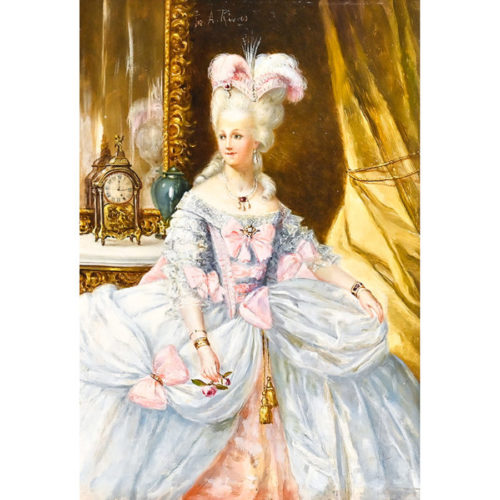 Refined panel painting depicting an elegant court lady by the Spanish painter Antonio Rivas (1845 - 1911). Painted from the late 19th century in excellent condition with gilded wood frame carved to simulate oak leaves. Period: End of the 19th century Measurements: In frame H 54,5 x W 43,5 x D 5 cm / Canvas H 33 x 23
Refined panel painting depicting an elegant court lady by the Spanish painter Antonio Rivas (1845 - 1911). Painted from the late 19th century in excellent condition with gilded wood frame carved to simulate oak leaves. Period: End of the 19th century Measurements: In frame H 54,5 x W 43,5 x D 5 cm / Canvas H 33 x 23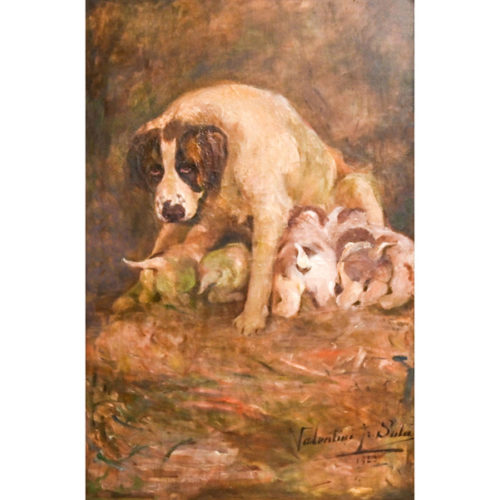 Large oil on canvas by the painter Irene VALENTINI-SALA (1864-1934), depicting "Litter", painting signed on the lower right and dated 1923, it is in excellent condition as it has just been restored. Irene Valentini Sala (Milan 1864 - Milan 1934), participates in the Italian Exhibition "Italian Exhibition Earl's Court" in London in 1904, organized by the Italian Chamber of Commerce in London, exhibiting the paintings "Impression" and "Venetian woman". In 1924 she participated in the Annual Exhibition at the Society for Fine Arts and Permanent Exhibition in the Palazzo di Brera in Milan, presenting the pastel "Crepuscolo" Period: 1923 Measurements: In frame H 148 x W 108 x D 8 / Canvas H 120 x W 80 cm
Large oil on canvas by the painter Irene VALENTINI-SALA (1864-1934), depicting "Litter", painting signed on the lower right and dated 1923, it is in excellent condition as it has just been restored. Irene Valentini Sala (Milan 1864 - Milan 1934), participates in the Italian Exhibition "Italian Exhibition Earl's Court" in London in 1904, organized by the Italian Chamber of Commerce in London, exhibiting the paintings "Impression" and "Venetian woman". In 1924 she participated in the Annual Exhibition at the Society for Fine Arts and Permanent Exhibition in the Palazzo di Brera in Milan, presenting the pastel "Crepuscolo" Period: 1923 Measurements: In frame H 148 x W 108 x D 8 / Canvas H 120 x W 80 cm